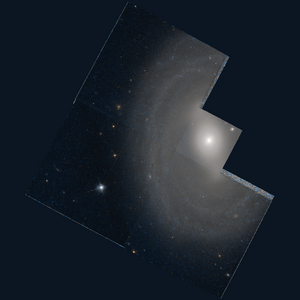NGC 6654
| Galaxy NGC 6654 |
|
|---|---|

|
|
| Photo from the Hubble Space Telescope | |
| AladinLite | |
| Constellation | Dragon |
|
Position equinox : J2000.0 , epoch : J2000.0 |
|
| Right ascension | 18 h 24 m 07.6 s |
| declination | + 73 ° 11 ′ 00 ″ |
| Appearance | |
| Morphological type | (R ') SB (s) 0 / a |
| Brightness (visual) | 11.9 likes |
| Brightness (B-band) | 12.8 mag |
| Angular expansion | 2.6 ′ × 2.1 ′ |
| Position angle | 0 |
| Surface brightness | 13.6 mag / arcmin² |
| Physical data | |
| Redshift | 0.006074 +/- 0.000033 |
| Radial velocity | 1821 +/- 10 km / s |
|
Stroke distance v rad / H 0 |
(90 ± 6) x 10 6 ly (27.7 ± 1.9) Mpc |
| history | |
| discovery | Lewis A. Swift |
| Discovery date | September 11, 1883 |
| Catalog names | |
| NGC 6654 • UGC 11238 • PGC 61833 • CGCG 340-045 • MCG 12-17-23 • IRAS 18252 + 7309 • 2MASX J18240752 + 7310597 • KARA 851 • 7ZW 793 | |
NGC 6654 is a lenticular hubble-type SB (s) 0 / a galaxy in the Dragon constellation in the northern sky, an estimated 90 million light years from the Milky Way .
The object was discovered on September 11, 1883 by the astronomer Lewis A. Swift with his 16-inch telescope and was later included in his New General Catalog by Johan Dreyer .
